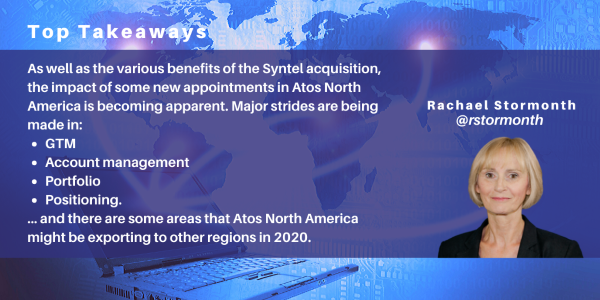posted on Nov 01, 2019 by Rachael Stormonth

What a difference a year makes.
Atos recently held its second North America business event in Dallas, just under a year since completing its acquisition of Syntel. Last year’s event focused on the newly formed Atos-Syntel organization in North America, and also on how, with a new CEO in place, North America was starting to address some legacy problems and to manage a situation where a chunk of business had gone away with some contract non-renewals: we felt that Atos North America was on a more positive trajectory than it had been in 2017, also that the integration with Syntel was being done less hastily than some of its previous large-scale IT services acquisitions (see our blog on the 2018 event here). This year, some major strides appear to have been made in North America in GTM, account management, portfolio and positioning – and there are some areas of good practice that Atos North America could export to other regions in time.
One priority has been to improve service delivery; if a very considerable improvement in NPS is anything to go by, this has been addressed. And issues in one problematic contract (going back to the acquisition of the IT services business of Xerox) have now been resolved.
In terms of portfolio, there has been a significant hiring of new talent, including a North America Digital Transformation Officer and a new head for its SAP practice, both with a mandate for offering development and innovation.
The new Digital Transformation Office is working on simplifying and packaging offerings from across the portfolio so that these resonate more closely with clients’ digitalization priorities, which it categorizes as:
- Being cloud ready
- Enhancing CX
- Improving innovation and agility
- Securing the business
- Using all their data
- Scaling their business
- Automating business processes.
That these are typically major priorities for enterprises today is undeniable. Overall, the messaging has come a long way from the product centricity of the Digital Transformation Factory; it is becoming more centered around use cases and on potential client benefits, though in some areas it remains a work in progress. Overall, there is an increasing emphasis on more flexible modular solutions from across the portfolio, and on flexible consumption models (the latter very different from some legacy infrastructure deals).
With SAP, Atos’ capabilities in North America have not historically been anywhere near as extensive as they are in geographies such as Germany and even the U.K., and they have focused on SAP BASIS ops. Initiatives in the last six months include setting up a small SAP consulting team as part of an ambition to target SAP transformation opportunities such as S/4HANA implementation/migration services; also, offering SAP HEC as a managed service on GCP. There are clearly strong ambitions here.
The fact that the global head of B&PS, Sean Narayanan, is based in New York indicates the importance being attached to Syntel. Benefits from the offshore delivery capabilities, the intelligent automation tools (the Syntbots platform) and agile delivery capabilities that Syntel has brought in should become apparent fairly quickly. Atos has completed the reverse integration of its larger B&PS contracts in other English-speaking geographies in a timely manner. Taking certain Syntel portfolio capabilities and exporting and expanding these across the group will take longer, as will developing more industry-specific offers for sectors such as healthcare payer and financial services.
While the Business & Platforms Solutions (B&PS) division in North America has been transformed with the addition of Syntel, the region’s legacy Atos Information & Data Management (IDM) division has also been busy, including working on adapting its GTM strategy. There has been a shift from the former pursuit of large managed services deals: the focus now is getting in front of clients earlier in their cloud journey and targeting smaller deal sizes such as cloud assessment engagements through which it can develop the relationship with the client to become a partner of choice for cloud design, migration and operations services.
Atos has said all year that North America would be back to organic growth by the end of 2019: in fact, it has achieved this in Q3. Something that perhaps would not have been expected a year ago is that the growth has come from IDM, which has done well to catch up the lost business from last year so quickly, rather than B&PS, which saw negative growth in its two priority sectors of healthcare and financial services
So, what next for North America? Of course, the ambition is to cross-sell the portfolio: this is likely to take time for a number of reasons, including little sector overlap in the region between legacy Atos and Syntel and lack of brand awareness. As we noted last year, in the short to mid-term, Atos North America is more likely to win broad-scope (infrastructure plus applications services) deals with mid-sized enterprises.
We expect to see an increasing focus in 2020 on vertical-specific offerings, most obviously healthcare, financial services and insurance.
And Atos North America might be exporting messaging about certain areas of the portfolio to the broader group; for example, the concept of ‘Singular IT’ mentioned a few times at the event – watch this space.
NelsonHall recently published an updated Key Vendor Assessment on Atos that includes its Q3 2019 results: for details, please contact [email protected]
